
Poa pratensis, commonly known as Kentucky bluegrass, smooth meadow-grass, or common meadow-grass, is a perennial species of grass native to practically all of Europe, North Asia and the mountains of Algeria and Morocco. Although the species is spread over all of the cool, humid parts of the United States, it is not native to North America. The Spanish Empire brought the seeds of Kentucky bluegrass to the New World in mixtures with other grasses. Poa pratensis forms a valuable pasture plant, characteristic of well-drained, fertile soil. It is also used for making lawns in parks and gardens and is common in cool moist climates like the Pacific Northwest, and Northeastern United States. When found on native grasslands in Canada, however, it is considered an unwelcome exotic plant, and is indicative of a disturbed and degraded landscape.
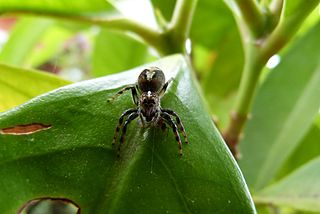
Frigga is a genus of jumping spiders that was first described by Carl Ludwig Koch in 1850. The name is derived from Frigga, a Norse goddess.
Nimbarus is a monotypic genus of Guinean jumping spiders containing the single species, Nimbarus pratensis. It was first described by C. Rollard & Wanda Wesołowska in 2002, and is only found in Guinea. The name is derived from the Nimba Mountains, where the species was first found. The species name is derived from the Latin "pratensis", meaning "meadow", for the habitat where this species can be found.
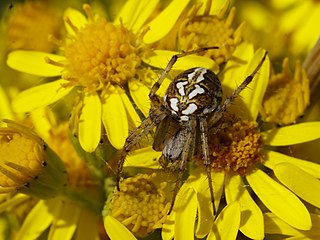
Neoscona, known as spotted orb-weavers and barn spiders, is a genus of orb-weaver spiders (Araneidae) first described by Eugène Simon in 1895 to separate these from other araneids in the now obsolete genus Epeira. The name Neoscona was derived from the Greek νέω, meaning "spin", and σχοῐνος, meaning "reed" They have a mostly pantropical distribution and one species, Neoscona adianta, has a palearctic distribution. As of April 2019 there are eight species that can be found in the United States and Canada:

Spider fighting or spider derby is a blood sport involving spiders that occurs in different forms in several areas of the world. Among them are the Philippines, Japan, and Singapore. The fights that occur in the Philippines and in Japan are staged between females of various species of web weavers. Female spiders will kill a rival if the loser does not quickly flee or receive the aid of a human handler. The contests that are staged in Singapore are fights between male jumping spiders. The males fight only for dominance, and ordinarily the loser will flee, though sometimes they will lose a leg in the fight.

Neoscona adianta is a species of spider belonging to the family Araneidae. It occurs in North Africa and Europe to Central Asia.

Helictotrichon pratense, known as meadow oat-grass, is a species of perennial grass in the family Poaceae, found in temperate parts of Europe, North Africa, and Asia. Its culms are erect and 30–85 cm long; leaves are mostly basal. It is restricted to shallow, calcareous soils such as those formed on chalk and limestone substrates.
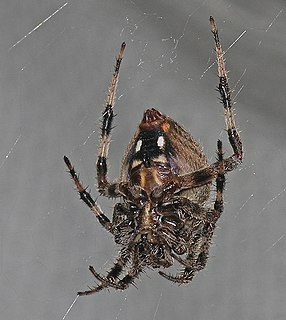
Neoscona crucifera is an orb-weaver spider in the family Araneidae. It is found in the United States from Maine to Florida in the east, to Minnesota in the Midwest, to Arizona in the southwest, and in Mexico. Its common names include Hentz orbweaver (after Nicholas Marcellus Hentz, spotted orbweaver, and barn spider. The name "barn spider" is also commonly used for a different spider, Araneus cavaticus.

Neoscona domiciliorum, commonly known as the spotted orbweaver or redfemured spotted orbweaver, is a spider in the family Araneidae. The specific epithet domiciliorum means "of dwellings" in Latin and refers to the fact that this species is often found living on buildings. Their bites are not known to cause serious harm in humans.
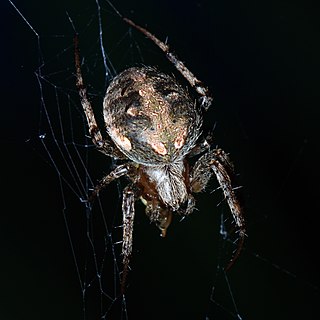
Neoscona arabesca is a common orb-weaver spider found throughout North America. Often called the arabesque orbweaver, after the cryptic, brightly colored, swirling markings on its prominent abdomen, this spider can be found in fields, forests, gardens, and on human structures. Neoscona species are among the most common and abundant orb weavers and are found on all continents. Females range in size from 5–7 mm (0.20–0.28 in) and males 5–6 mm (0.20–0.24 in).

Neoscona oaxacensis, known as western spotted orbweaver and zig-zag spider, is a species of spider in the family Araneidae. It is distributed in the Americas, from Kansas and California south to Venezuela and Peru, including the Galápagos Islands.
Herbiphantes is a genus of Asian dwarf spiders that was first described by A. V. Tanasevitch in 1992. As of May 2019 it contains only three species, found in Japan, Korea, and Russia: H. cericeus, H. longiventris, and H. pratensis.

Neoscona theisi is a species of spider in the family Araneidae. Spiders in the genus Neoscona have a mostly pantropical distribution.

Araneus pratensis is a species of orb weaver in the spider family Araneidae. It is found in the United States and Canada.
Neoscona utahana is a species of orb weaver in the spider family Araneidae. It is found in the United States and Mexico.
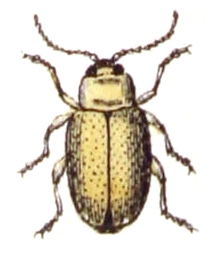
Longitarsus pratensis is a species of flea beetle in the family Chrysomelidae. It is found in Europe & Northern Asia and North America.

Neoscona nautica, the brown sailor spider, is a species of orb weaver in the family Araneidae. It is found in Asia and Pacific islands, has been introduced into both Americas, and Sudan.

Agroeca pratensis is a species of liocranid sac spider in the family Liocranidae. It is found in the United States and Canada.

Neoscona byzanthina is an orb-weaver spider.















